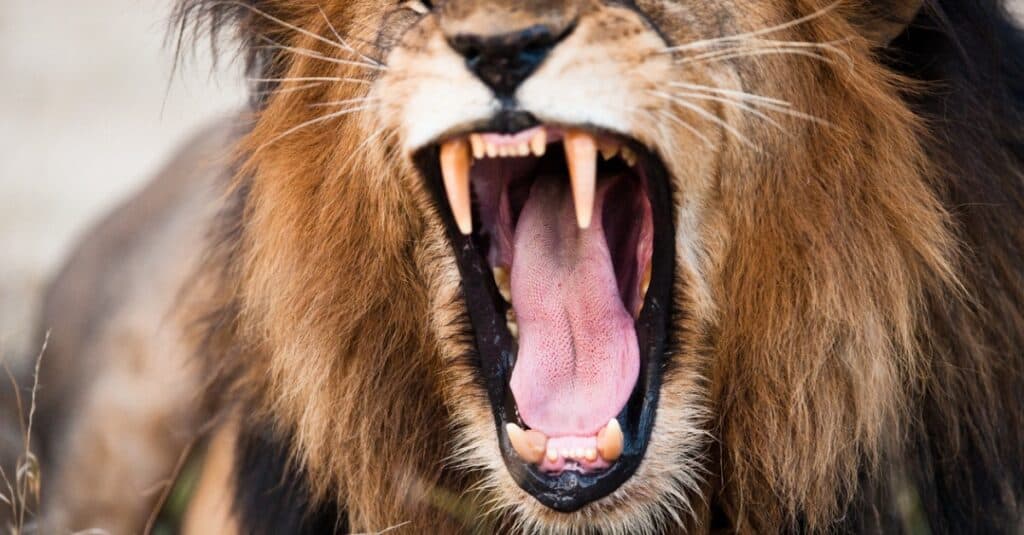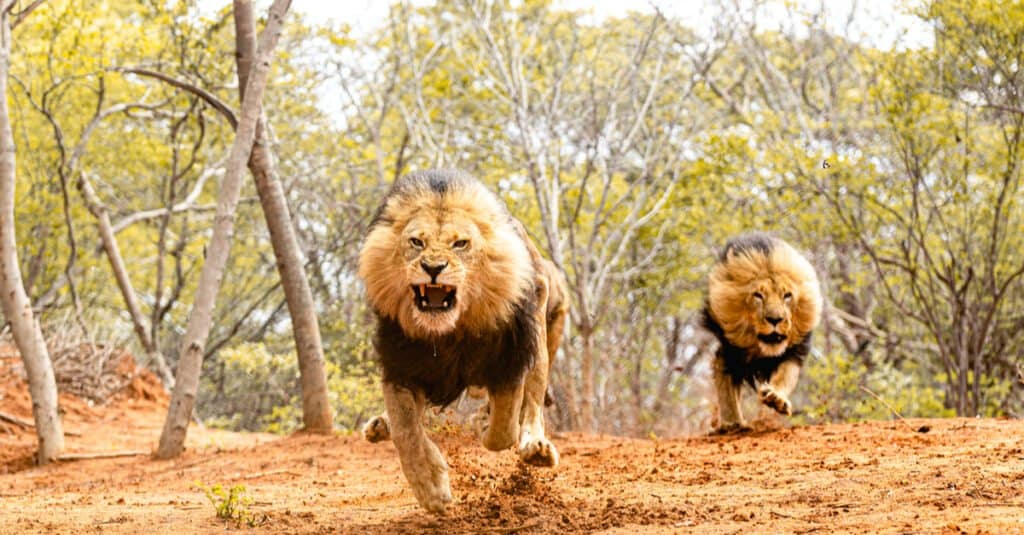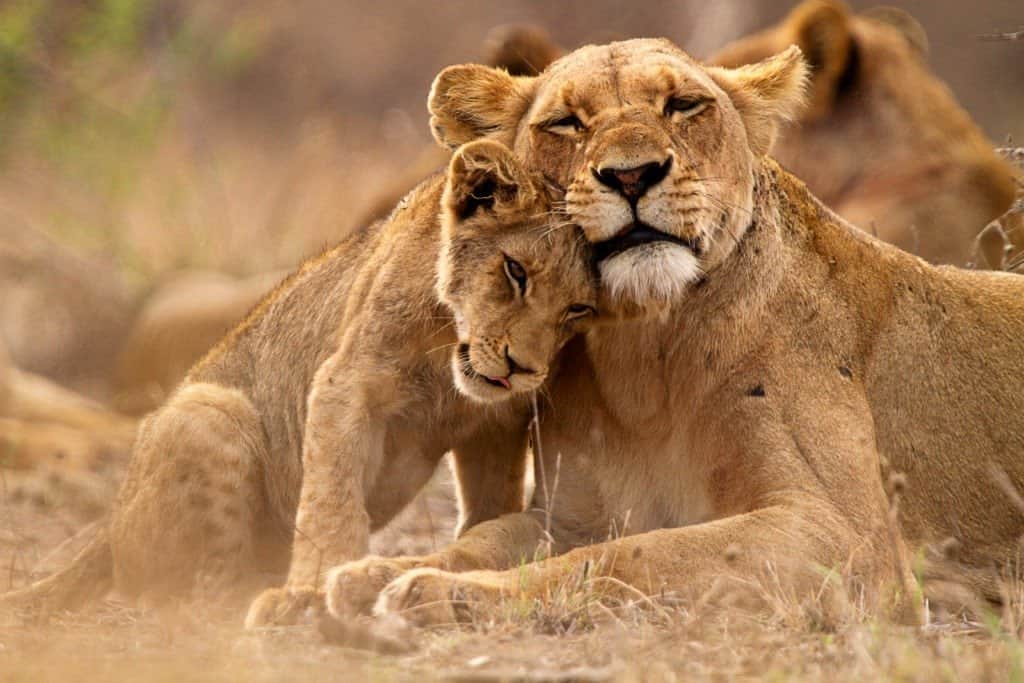Lions are known as the king of the jungle, but they’re not meaningless figureheads. They earned that title by being some of the most dangerous apex predators on the planet. For the most part, humans have lost their respect for these large mammals, though. Our superior technology combined with lower numbers of lions in the wild has insulated humanity from these cunning predators. That’s why we’re going to examine the deadliest lion attacks in human history.
By the time we get through this list, we’ll show you why humans should feel a new appreciation for the power of lions. Without further ado, let’s start by taking a look at what makes lions so powerful.
What Makes Lions So Dangerous?

Lions can open their mouths nearly a foot, and their long teeth can puncture skulls.
©iStock.com/3dan3
| Size | Weight: 261lbs – 550lbs Length: 4.7ft – 8.2ft |
| Speed | 35 mph |
| Senses | -Amazing sense of sight, especially night vision -Good sense of smell capable of smelling other lions’ markings -Great hearing allows them to hear prey miles away |
| Defenses | – Stays with pride for safety in numbers – Large size – Can quickly run away from enemies |
| Offensive Powers | – Sharp claws can gash foes – Paw strikes can deliver a powerful, staggering blow – Strong biting power can splinter bones and tear prey open. |
| Predatory Behaviors | – Endurance predator or ambush predator – Works as a group to take down prey |
Lions are massive mammals that are loaded with muscle and the power to kill. A single lion has the ability to attack and kill multiple humans in a single event. Their skill with attacking from stealth and killing with a single bite makes them well-suited to inflicting fatal wounds.
Also, when you consider that lions often hunt in packs called pride, it’s easier to imagine how these big cats wreak havoc on populations of animals, including humans.
Are Lions Usually Dangerous to Humans?

Ever since the first interactions with humans, lions have presented a serious danger.
©Blue Slate Films/Shutterstock.com
Lions have always been dangerous to humans, and there will always be the potential for them to harm humans. Fully armed hunters with modern rifles have been attacked and almost perished with what amounts to a firing squad vs a single lion.
Lion attacks are not uncommon in places where they live in close proximity to humans, and about two people per year are killed by these animals that we know about.
For the most part, lions are not a large problem for human beings. People don’t live as close to them now as they did in the past. However, some individuals can become victims of lion attacks by putting themselves in harm’s way.
Hunters and safari guides both get closer to lions than they should if they want to guarantee their safety. Sometimes, by trying to shoot a lion for sport or helping their customers get a good look at wild lions, these individuals put themselves and others in danger.
Yet, it’s safe to say that lions will never again terrorize people as they did during the deadliest lion attacks in history. Take a look and see why.
Deadliest Lion Attacks in History: The Man-Eaters of Njombe

Lion cubs learned to hunt humans from their lioness mothers.
©Thomas Retterath/Shutterstock.com
The deadliest lion attack in history led to the deaths of 1,500 people in the Njombe area of modern-day Tanzania. This attack did not occur all at once, of course. That would be truly terrifying. Instead, these attacks were spaced out over 15 years from 1932 to 1947.
During that time, three generations of lions were born and started to hunt human beings in the area as a pride. It’s believed that the first generation of lions to hunt humans did so due to competition for food and land. Eventually, the lions started to use the same tactics to hunt humans as they did animals with nighttime ambushes.
Also, since the young lions learned how to hunt from the older lions, they simply copied the behaviors. On average, they were taking nearly a hundred people per year. Eventually, professional hunters were called in to deal with the threat. A total of 15 lions were identified in the final generation and hunted down by a man named George Gilman Rushby.
The interesting thing about the man-eating behavior is that the lions began to overlook the cattle being raised around the area in favor of killing humans.
Based on studies performed by experts in the following years, lions may have developed specific techniques to hunt humans. Most worryingly, attacks in the area started to pick up again decades later in 2006.
The Tanzanian lions were just as bold and effective. Some reports claimed that the lions killed upwards of 40 people, sometimes dragging them from their homes. Is it possible that Rushby failed to eliminate all the man-eaters? In 2020, three children were killed and eaten while one was left injured by a single lion in Tanzania. Attacks in this area happen quite frequently.
Deadliest Lion Attacks in History: The Tsavo Man-Eaters

A pair of lions killed dozens of people between March and December 1898.
©iStock.com/Bernard Bialorucki
Another of the deadliest lion attacks in history happened in Tsavo, Kenya. In 1898, two man-eating males began picking off and killing people. It’s believed that somewhere between 30 and 100 individuals were killed, with the former total being more likely than the latter.
The killings became so frequent that the men working on the Kenya-Uganda railway began to flee the area. The lions were unusually bold, and they would actively prowl the workers’ campsites and drag them from their lodgings to kill them.
As a result, a man named John Henry Patterson was tasked with killing the creatures. He recruited dozens of men, set traps, and eventually hunted the two lions down and killed them. Their skins and skulls are still on display in a museum to this day.
Many potential justifications for the attacks exist. Some people blame infected teeth for making the lions seek easier prey. Others say it was a lack of available food that led to them dining on humans. Either way, the nine months of terror these two lions wrought on humans in the area will never be forgotten.
The Tsavo man-eaters and the Njombe man-eaters are just two of the deadliest series of lion attacks in human history. For better or worse, they did not happen long ago. As a result, we have records to examine. Even deadlier lion predation events may have happened in the past. While it’s unlikely such devastating attacks will occur in the future, lions will always pose a danger as long as they’re near human settlements.
The photo featured at the top of this post is © 2021 Photography/Shutterstock.com
Thank you for reading! Have some feedback for us? Contact the AZ Animals editorial team.







